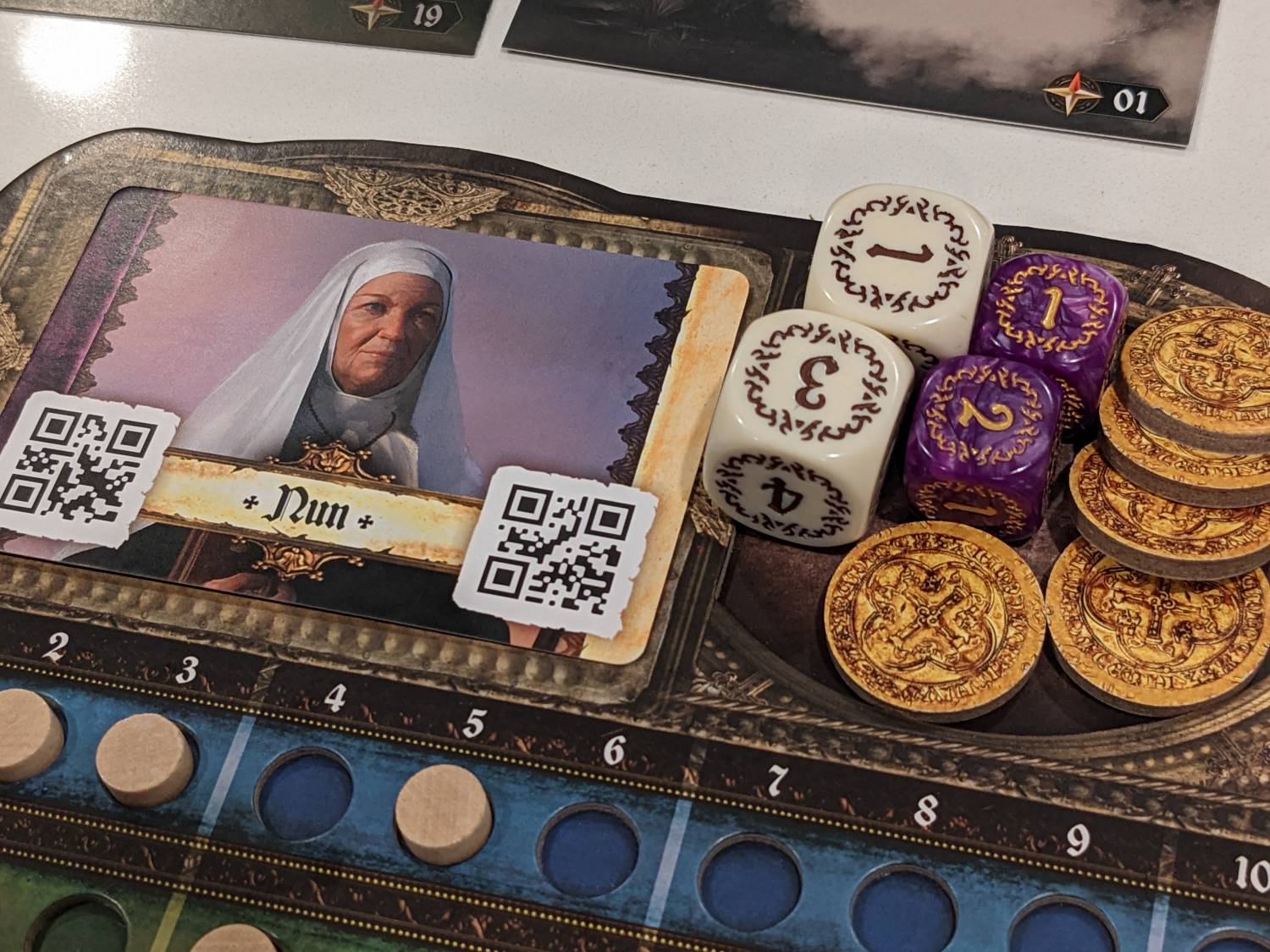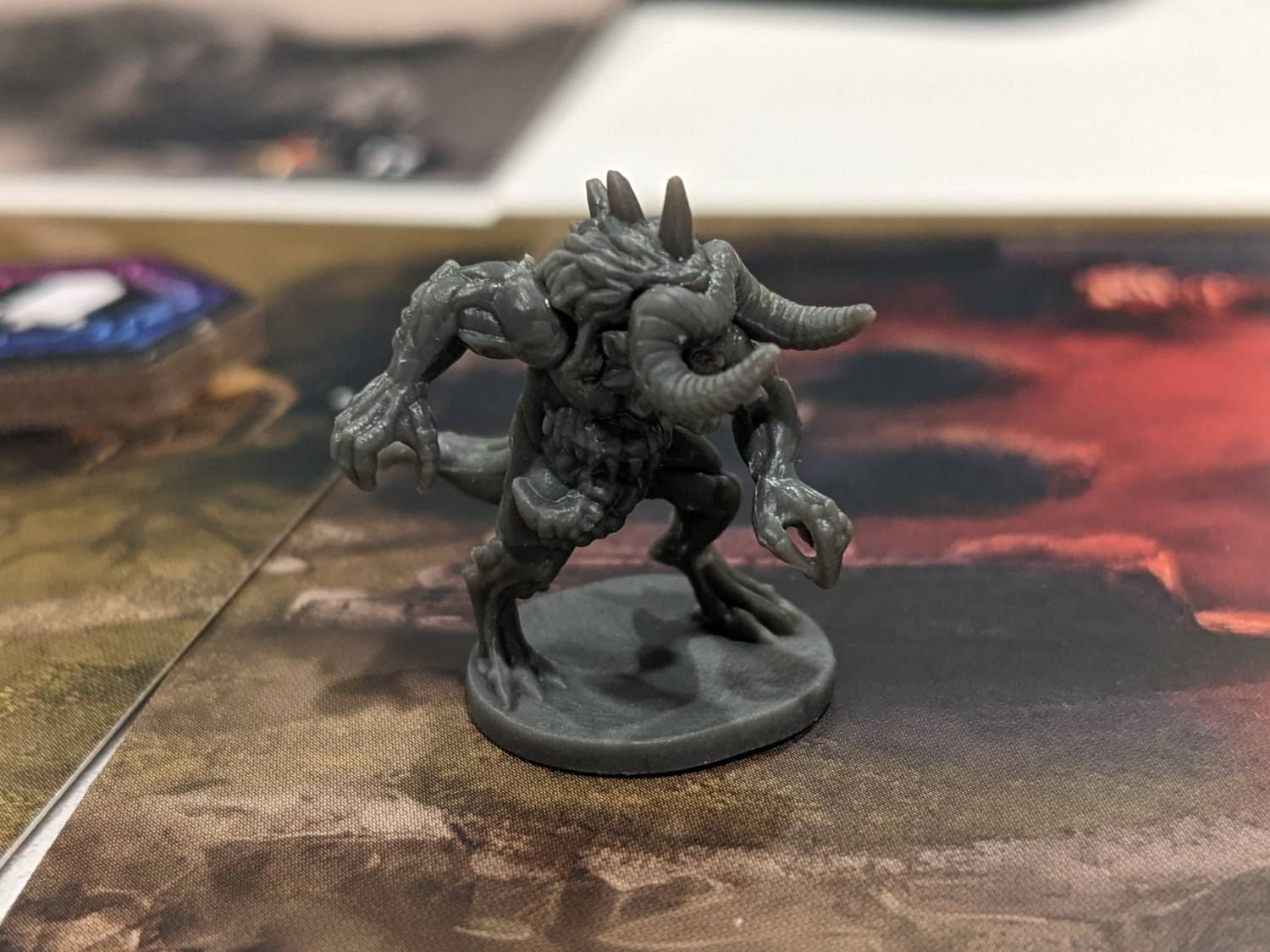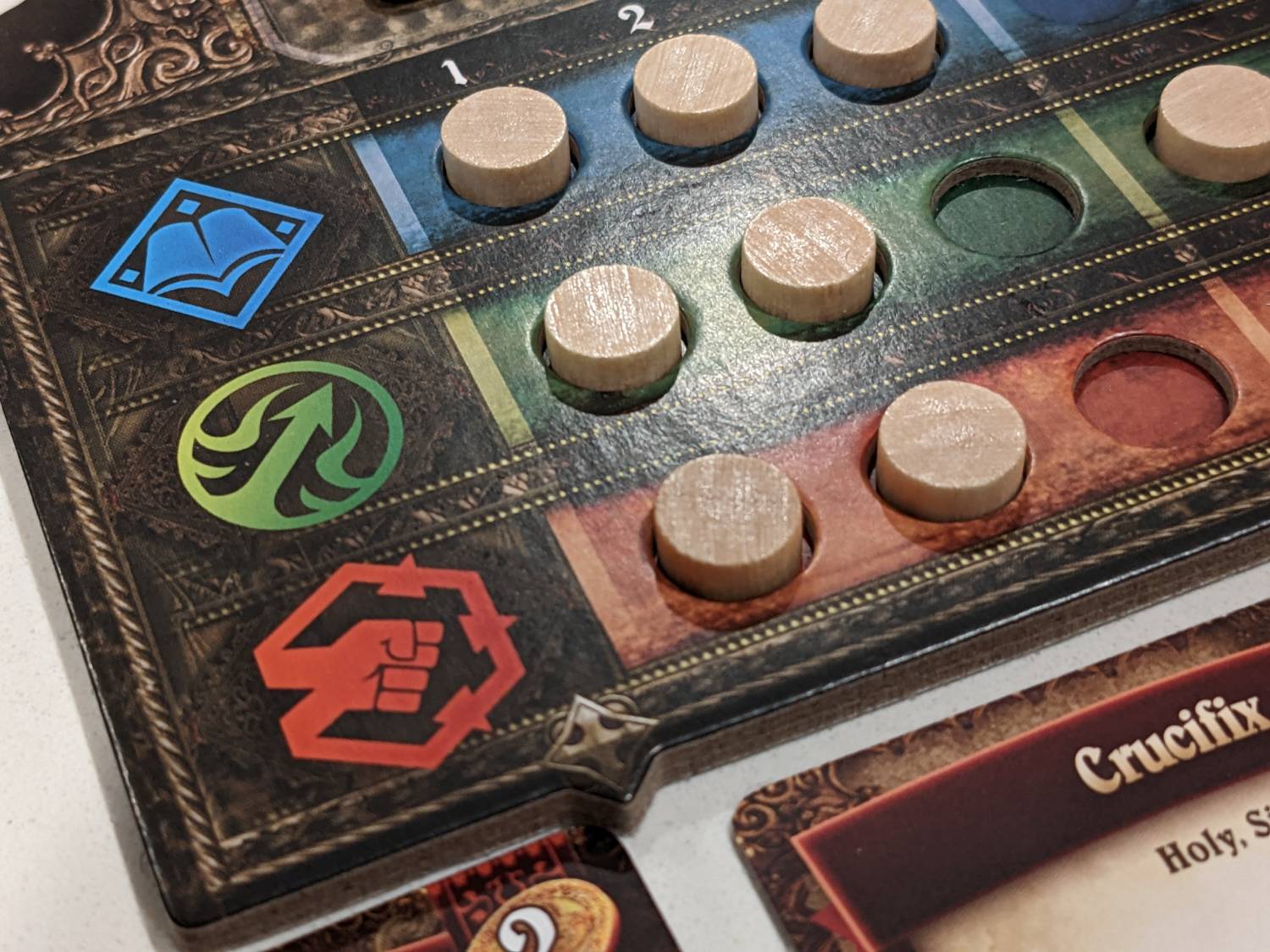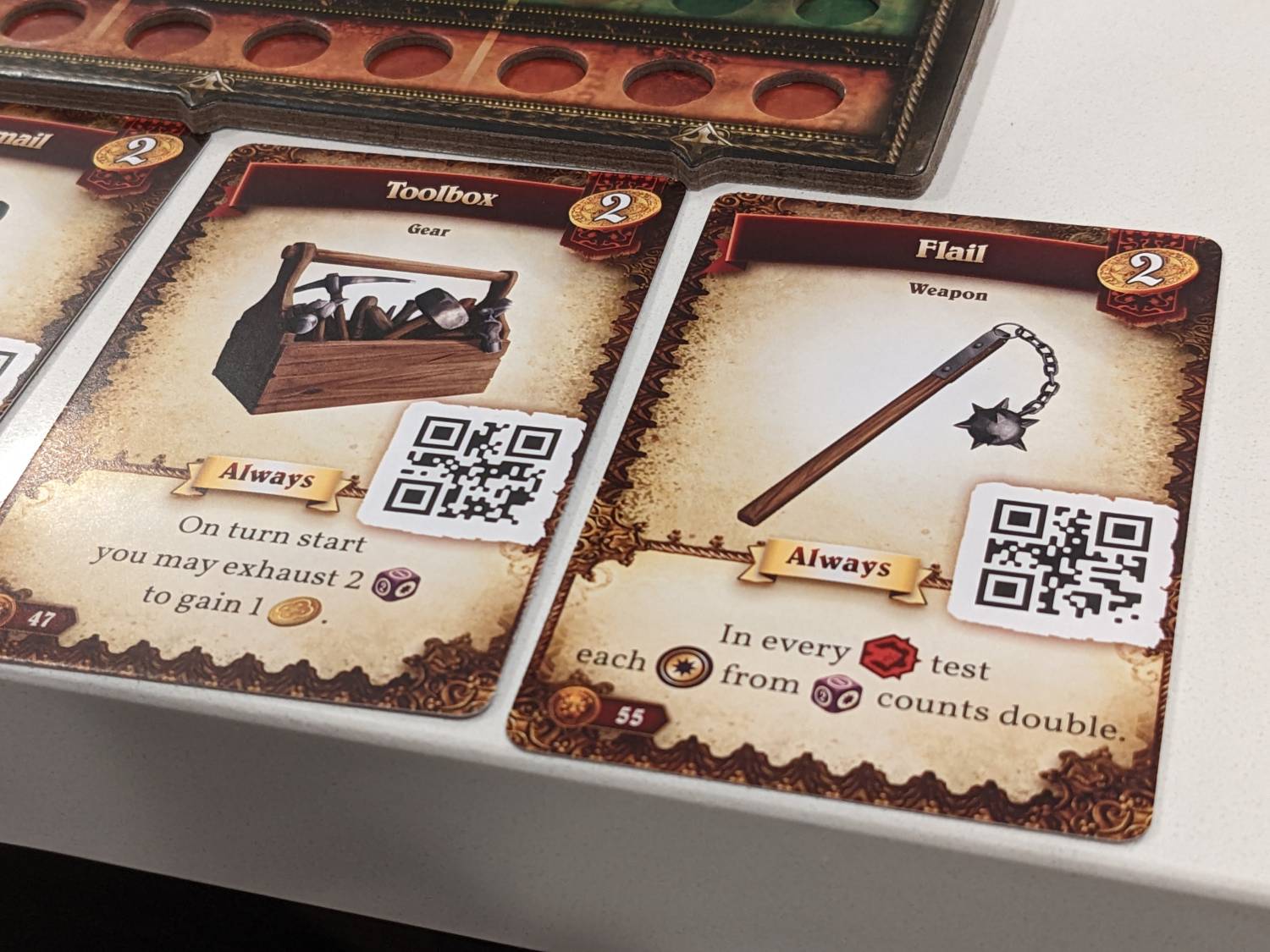Disclosure: Meeple Mountain received a free copy of this product in exchange for an honest, unbiased review. This review is not intended to be an endorsement.
Is it a game? A game system? One big QR code?
I’m still not sure where I land on Destinies (2021, Lucky Duck Games) because it’s such a hybrid experience. I know it’s an app-driven RPG in a competitive play format that plays 1-3 players.
But from there, I’m torn. Some people love games—or maybe, “games”, depending on your point of view—where everything you do is driven by an app. I actually don’t mind this as long as the interaction with the app is minimal.
Where I’m struggling is the overall experience. When I won my second play of the game, a solo Explorer variant of the first campaign module, I didn’t feel like I had won. The app said I won, though, so that means I won, right?
Destinies is a tricky proposition. Many of the elements are rock solid, but other elements leave you feeling the same way I felt after my second game. It made future plays harder to forecast.

It’s Day 39 (Press OK)
Destinies was designed as the first in the “Destinies System”: app-driven role-playing game (RPG) experiences where players would share a map but compete separately to achieve their personal character’s destiny. That destiny is usually either a peaceful resolution, in the form of a fetch quest, or a violent one, where the player would need to kill something, or maybe kill something that is carrying something that could be forged into something else for the sole purpose of defeating a different bad guy.
The first thing I noticed about Destinies: the miniatures. Some of these sculpts are stellar; I don’t know why these are so nice, since many of the minis are not on the map for very long. No matter: the miniatures are great, and the quality production elements shine through every part of the Destinies package.
The dice are beautiful. The insert is perfect. The player boards are impressive and didn’t warp during their time waiting to arrive in my hot little hands. Great rulebook. The card stock is strong and the artwork on each of the game’s tiles, laying out the town where Destinies is set, is also excellent. The box has heft, and that heft delivers in the form of quality through and through.
The second thing I noticed were the QR codes on every single Destinies card. (The official name for the game’s structure is Scan & Play, so you’ll need a device equipped with a camera to take many actions in the game.) There are QR codes everywhere in Destinies, and I’m still not sure where I land on this. In the COVID era, Americans were forced to use QR codes to scan restaurant menus damn near everywhere for a couple of years.

But in Destinies, these QR codes are used to interact with the game’s app to have various in-game characters tell you more about that lockpick or sword you are holding. Or, maybe you are holding a rosary, and multiple people will remind you how important praying for forgiveness is during troubling times. Even your character card has QR codes—two of them!—so that you can ask various characters about tips on how to achieve one of your personal destiny’s victory conditions.
Destinies made me think hard about why I like playing board games in person: to be away from screens. That makes interacting with an app even harder; I only signed on to play games to get away from a screen, yet this game requires me to enter everything into the app to drive the action.
Movement? Use the app to pick your new tile, even though you have a physical tile in front of you. Skill checks and attribute tests? Roll the dice in real life, then enter your total in the app to see what happens next. Walk into the blacksmith’s building? Now that you’re here, pick from one of the five choices on the screen. One of those choices is usually “Ask the ____ about your destiny”, which allows for you to scan another QR code to see what this character can offer in terms of advice on future choices.
None of this is a problem on its own, but as a 60-to-90-minute gaming experience, it really wore on me:
- Use the app to confirm that it is your turn—”Day 39—Nun—Recover One Effort Die”, the game will say for roughly the 39th time
- Tap an interest area on the map, then add additional tiles, then roll dice to complete tests
- Work through 2-5 on-screen prompts to see what you’ve learned
- Regularly discover new tiles, adding those to the growing map, or add 4-8 cards from a master deck with items you can buy in shops
- Lather, rinse, repeat
It is not an exaggeration to say that Destinies often feels more like an exercise than a game. Having agency to make choices that could be detrimental is sorely lacking in about 75% of the game’s interactions.

Thematic? Uhh…
Destinies is set in a dark fantasy world (which I don’t believe is ever named) where choices matter. For a long-time video gamer, hundreds of games have taken advantage of this to great effect: The Witcher, Mass Effect, XCOM, Fallout, and many more.
Destinies sells itself as a game that is unique in this way, which I think is both right and wrong. For a tabletop gamer, this does feel novel, but for a video game fanatic, this is old news. In the Dragon Age video games, you could do this kind of thing 10 years ago. Same for Mass Effect and the Fallout franchise where actions have ramifications throughout the game—for instance, providing help to an ally’s faction early in a game could lead to that ally “remembering” that you helped them to affect future choices.
In Destinies, I can’t really tell what the hook is. Worse, the theme for each character is different…until it is not.
Here’s an example. In that second game, I played as the Nun for the first campaign session (of the four included, and the designers recommend playing the campaign in order), and to begin play, she is given a rosary. This felt right: I’m a woman of the cloth, so I should have a rosary.
But by the midpoint of this game, I had some other things that didn’t quite feel right. Swords? Well, I guess that eventually, you’re going to have to fight other beings in the world. But why not something like holy water instead? Or maybe the ability to fight evil with something grabbed from a church, like a small crucifix?
Late in that game, I found my sword-wielding nun wearing chain mail armor. Chain mail? For a woman of the cloth?
In that same game, I had to scale a ladder inside of a barn. That felt right; I need to get up to the second level of the barn to check out what’s going on up there.
But I ended that turn with a ladder in my possession. Yes, a ladder. Worse, this ladder had a power to affect die rolls on future turns.
So, you’re saying I have a limit of five items to carry around the game world, but I can throw a ladder in my oversized book bag? And you’re saying that the ladder doesn’t allow me to scale any other building in the game later, and it also affects the die rolls for attribute checks that have nothing to do with what a ladder might really be used for?
The moment this ladder bit happened, I found myself slowly falling off of the Destinies bandwagon.

Solo Roguelike
My first game of Destinies was a solo game where I went through the Challenger mode, in which I only had eight turns to beat the game.
While I got absolutely smoked (there are ways to add turns to the game, but not much in my experience), I love that Destinies has a roguelike version attached. Similar to The Binding of Isaac and some other video game roguelikes I’ve played in recent years (Slay the Spire and Darkest Dungeon come to mind), Destinies, in its Challenger mode, is simply meant to educate, as well as speed up what could turn into a long game in the wrong hands.
Which is why I would recommend solo if you are going to make the leap to buy this game. Downtime in Destinies is the biggest reason why I am glad Lucky Duck went with a max of three players and not four. I can’t even imagine Destinies at two players because solo plays so much faster and delivers the same payoff that a multiplayer experience would for me.

It’s a Chore. Beautiful, But a Chore
Destinies is a classy, well-built production that won’t work for everyone. It didn’t work for me.
Games that feature analog gameplay with a taste of app-based features? Count me in. But almost all of Destinies plays through the app. I’d rather play a video game instead.
Solo is the way to go here—in fact, all of my four plays were solo. While Destinies is not for me, I will recommend this to solo gamers who like app-based play wholeheartedly. After a single read of the excellent rulebook, I knew all that I needed to get moving and launch the app. With no other players to slow me down, I was able to play Destinies in 30-60 minutes solo, with games in Challenger going a bit shorter since I was losing so fast.
The physical production is beautiful but in many ways feels wasted. I was surprised how often I pulled out a miniature, only to never really interact with it. The minis bring the app to life but not enough to justify this much plastic in the box.
On my final play, in the second of four scenarios in the campaign, I didn’t even pull out the tiles and miniatures. Sticking with just the app and the deck of cards kept my play area clean, and I just moved around on the app when I needed to look at a new tile.
That I could even do that and get away with not setting up half of the game was quite telling. Destinies has added four expansions, so I’ll hold onto my copy to see how those expansions change the game. As a two-player co-op, I could see Destinies as a potential experience for my wife and I to try, especially if expansions help the game break away from such a heavy reliance on the app.












Add Comment